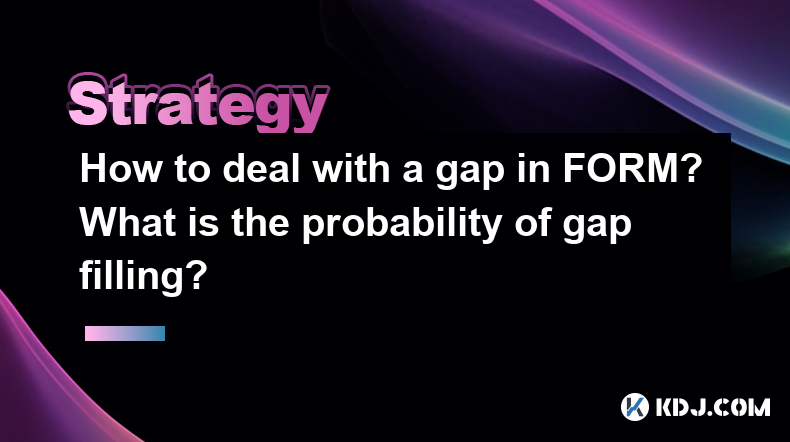-
 bitcoin
bitcoin $121833.232455 USD
-0.63% -
 ethereum
ethereum $4394.437030 USD
-2.00% -
 tether
tether $1.000570 USD
0.04% -
 bnb
bnb $1255.553465 USD
-3.73% -
 xrp
xrp $2.814944 USD
-1.59% -
 solana
solana $221.835346 USD
-2.40% -
 usd-coin
usd-coin $0.999869 USD
0.01% -
 dogecoin
dogecoin $0.249495 USD
-1.32% -
 tron
tron $0.336905 USD
-1.24% -
 cardano
cardano $0.816464 USD
-1.69% -
 chainlink
chainlink $22.130946 USD
-1.27% -
 hyperliquid
hyperliquid $44.208522 USD
-3.46% -
 ethena-usde
ethena-usde $1.000521 USD
0.02% -
 sui
sui $3.422897 USD
-2.51% -
 stellar
stellar $0.380164 USD
-1.31%
How to deal with a gap in FORM? What is the probability of gap filling?
Gaps in FORM occur when crypto prices shift sharply without trading; traders use strategies like holding, closing positions, or entering new trades to manage them.
May 03, 2025 at 09:22 pm

Understanding Gaps in FORM
In the world of cryptocurrency trading, gaps refer to areas on a price chart where the price of an asset moves sharply up or down with no trading occurring in between. These gaps can be particularly noticeable in the context of FORM (Futures and Options Risk Management), where traders often encounter them due to the high volatility and leverage associated with futures and options trading. A gap in FORM can occur overnight, over weekends, or during times of significant news events, leaving traders to deal with the sudden shift in price levels.
Types of Gaps in FORM
There are primarily three types of gaps that traders might encounter in FORM:
- Breakaway Gaps: These occur when the price breaks out of a trading range or a consolidation period, often signaling the start of a new trend.
- Runaway Gaps: Also known as continuation gaps, these happen within a trend and indicate that the trend is likely to continue.
- Exhaustion Gaps: These appear near the end of a trend and signal that the trend is about to reverse.
Understanding the type of gap you are dealing with can help you decide the best course of action to take.
Strategies for Dealing with Gaps in FORM
When facing a gap in FORM, traders have several strategies they can employ:
- Holding Through the Gap: If you believe in the long-term potential of the asset, you might choose to hold your position through the gap, especially if it's a breakaway or runaway gap.
- Closing the Position: If the gap is significant and you are unsure about the direction of the market, closing your position might be the safest option to avoid further losses.
- Adjusting Stop-Loss Orders: If you have a stop-loss order in place, you might need to adjust it to account for the gap, ensuring that it still provides adequate protection.
- Entering New Positions: Gaps can present trading opportunities. For instance, a breakaway gap might be a signal to enter a new position in the direction of the gap.
Probability of Gap Filling
The probability of a gap filling, or closing, depends on several factors:
- Type of Gap: Breakaway and runaway gaps are less likely to fill immediately, while exhaustion gaps have a higher probability of filling as they signal the end of a trend.
- Market Conditions: In highly volatile markets, gaps are more likely to fill as traders take advantage of the volatility to push prices back to previous levels.
- Time Frame: Gaps that occur on shorter time frames are more likely to fill than those on longer time frames.
Analyzing Historical Data
To better understand the probability of gap filling in FORM, traders often analyze historical data. By looking at past instances of gaps and how they were filled, traders can gain insights into the likelihood of future gaps filling. This involves:
- Collecting Data: Gathering historical price data for the asset in question.
- Identifying Gaps: Marking all instances of gaps on the chart.
- Tracking Fill Rates: Noting how often and how quickly these gaps were filled.
- Analyzing Patterns: Looking for patterns in the data that might indicate higher or lower probabilities of gap filling under certain conditions.
Tools and Indicators for Gap Analysis
Several tools and indicators can help traders analyze gaps in FORM:
- Gap Scanner: A tool that scans the market for gaps in real-time, helping traders identify potential trading opportunities.
- Volume Analysis: High volume during a gap can indicate strong interest and a lower likelihood of the gap filling immediately.
- Candlestick Patterns: Certain candlestick patterns, such as doji or hammer, can signal potential reversals and gap filling.
- Moving Averages: These can help traders determine the overall trend and whether a gap is likely to fill within the context of that trend.
Practical Steps for Dealing with Gaps in FORM
Here are some practical steps traders can take when dealing with gaps in FORM:
- Monitor the Market: Keep an eye on the market, especially during times when gaps are more likely to occur, such as before and after major news events.
- Use Alerts: Set up price alerts to notify you when a gap occurs, allowing you to react quickly.
- Review Your Strategy: Assess your current trading strategy and decide whether it needs to be adjusted in light of the gap.
- Consult Historical Data: Use historical data to inform your decision-making process regarding the likelihood of the gap filling.
- Adjust Risk Management: Modify your risk management strategies, such as stop-loss orders, to account for the new price levels after the gap.
Frequently Asked Questions
Q: Can gaps in FORM be predicted?A: While gaps cannot be predicted with certainty, traders can use historical data and market analysis to identify conditions that are more likely to lead to gaps. Monitoring market volatility, news events, and using gap scanners can help traders anticipate potential gaps.
Q: How does leverage affect the impact of gaps in FORM?A: Leverage can significantly amplify the impact of gaps in FORM. Since futures and options trading often involves high leverage, even a small gap can lead to substantial gains or losses. Traders need to be particularly cautious and manage their leverage carefully when dealing with gaps.
Q: Are there specific cryptocurrencies more prone to gaps in FORM?A: Yes, cryptocurrencies with higher volatility and lower liquidity are more prone to gaps in FORM. For example, smaller altcoins might experience more significant gaps than major cryptocurrencies like Bitcoin and Ethereum, which have higher liquidity and more stable trading volumes.
Q: How can traders use gaps in FORM to their advantage?A: Traders can use gaps in FORM to enter new positions or to exit existing ones strategically. For instance, a breakaway gap might signal a good entry point for a new trade, while an exhaustion gap could be a signal to exit a position before a potential reversal. Additionally, traders can use gaps to adjust their stop-loss orders and manage risk more effectively.
Disclaimer:info@kdj.com
The information provided is not trading advice. kdj.com does not assume any responsibility for any investments made based on the information provided in this article. Cryptocurrencies are highly volatile and it is highly recommended that you invest with caution after thorough research!
If you believe that the content used on this website infringes your copyright, please contact us immediately (info@kdj.com) and we will delete it promptly.
- TT Jagannathan: The Prestige Founder Who Revolutionized Indian Kitchens
- 2025-10-10 12:25:15
- Bitcoin's Open Interest Dip: What's the Deal?
- 2025-10-10 12:25:15
- Dogecoin, Litecoin, and BlockDAG: Crypto's Old Guard Meets the New Kid
- 2025-10-10 12:30:02
- MOBU BTC: Why MoonBull Could Be Your Next Crypto Obsession
- 2025-10-10 12:45:14
- Coinbase, Staking, and the Crypto Scene: A New York State of Mind
- 2025-10-10 12:30:02
- Chainlink, Reserve, LINK Price: Decoding the Signals
- 2025-10-10 10:45:14
Related knowledge

Practical parameter settings for a Bitcoin multi-timeframe moving average system
Sep 18,2025 at 10:54pm
Optimizing Timeframe Combinations for Bitcoin Trading1. Selecting appropriate timeframes is crucial when building a multi-timeframe moving average sys...

How can I filter out false breakouts in Dogecoin high-frequency trading?
Sep 22,2025 at 01:00am
Understanding False Breakouts in Dogecoin Trading1. A false breakout occurs when Dogecoin's price appears to move beyond a defined support or resistan...

Techniques for identifying tops and bottoms in the Bitcoin on-chain NVT model
Sep 20,2025 at 07:54pm
Understanding the NVT Model in Bitcoin Analysis1. The Network Value to Transactions (NVT) ratio is often described as the 'P/E ratio' of the cryptocur...

What does the surge in open interest in Bitcoincoin futures mean?
Sep 20,2025 at 11:18pm
Understanding the Surge in Dogecoin Futures Open Interest1. A surge in open interest within Dogecoin futures indicates a growing number of active cont...

How can I use the Ethereum USDT premium to gauge market sentiment?
Sep 18,2025 at 11:55pm
Understanding the Ethereum USDT Premium1. The Ethereum USDT premium refers to the price difference between USDT (Tether) traded on Ethereum-based plat...

What should I do if Ethereum staking yields decline?
Sep 20,2025 at 06:18am
Understanding the Causes Behind Declining Ethereum Staking Yields1. The Ethereum network transitioned to a proof-of-stake consensus mechanism with the...

Practical parameter settings for a Bitcoin multi-timeframe moving average system
Sep 18,2025 at 10:54pm
Optimizing Timeframe Combinations for Bitcoin Trading1. Selecting appropriate timeframes is crucial when building a multi-timeframe moving average sys...

How can I filter out false breakouts in Dogecoin high-frequency trading?
Sep 22,2025 at 01:00am
Understanding False Breakouts in Dogecoin Trading1. A false breakout occurs when Dogecoin's price appears to move beyond a defined support or resistan...

Techniques for identifying tops and bottoms in the Bitcoin on-chain NVT model
Sep 20,2025 at 07:54pm
Understanding the NVT Model in Bitcoin Analysis1. The Network Value to Transactions (NVT) ratio is often described as the 'P/E ratio' of the cryptocur...

What does the surge in open interest in Bitcoincoin futures mean?
Sep 20,2025 at 11:18pm
Understanding the Surge in Dogecoin Futures Open Interest1. A surge in open interest within Dogecoin futures indicates a growing number of active cont...

How can I use the Ethereum USDT premium to gauge market sentiment?
Sep 18,2025 at 11:55pm
Understanding the Ethereum USDT Premium1. The Ethereum USDT premium refers to the price difference between USDT (Tether) traded on Ethereum-based plat...

What should I do if Ethereum staking yields decline?
Sep 20,2025 at 06:18am
Understanding the Causes Behind Declining Ethereum Staking Yields1. The Ethereum network transitioned to a proof-of-stake consensus mechanism with the...
See all articles

























![Web3 Crypto Market Morning Report: Fomo on the Bnb chain continues, Binance launches the chain-sweeping platform Meme Rush, the market value of Xiuxian exceeds 40 million U.S. dollars, OK Binance business war begins [Vic TALK Issue 1437] Web3 Crypto Market Morning Report: Fomo on the Bnb chain continues, Binance launches the chain-sweeping platform Meme Rush, the market value of Xiuxian exceeds 40 million U.S. dollars, OK Binance business war begins [Vic TALK Issue 1437]](/uploads/2025/10/10/cryptocurrencies-news/videos/web-crypto-market-morning-report-fomo-bnb-chain-continues-binance-launches-chainsweeping-platform-meme-rush-market-xiuxian-exceeds-dollars-binance-business-war-vic-talk-issue/68e861c5dbd1c_image_500_375.webp)
















































